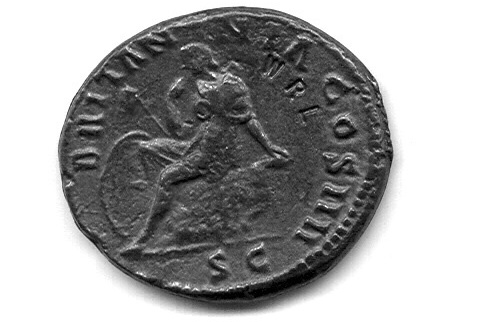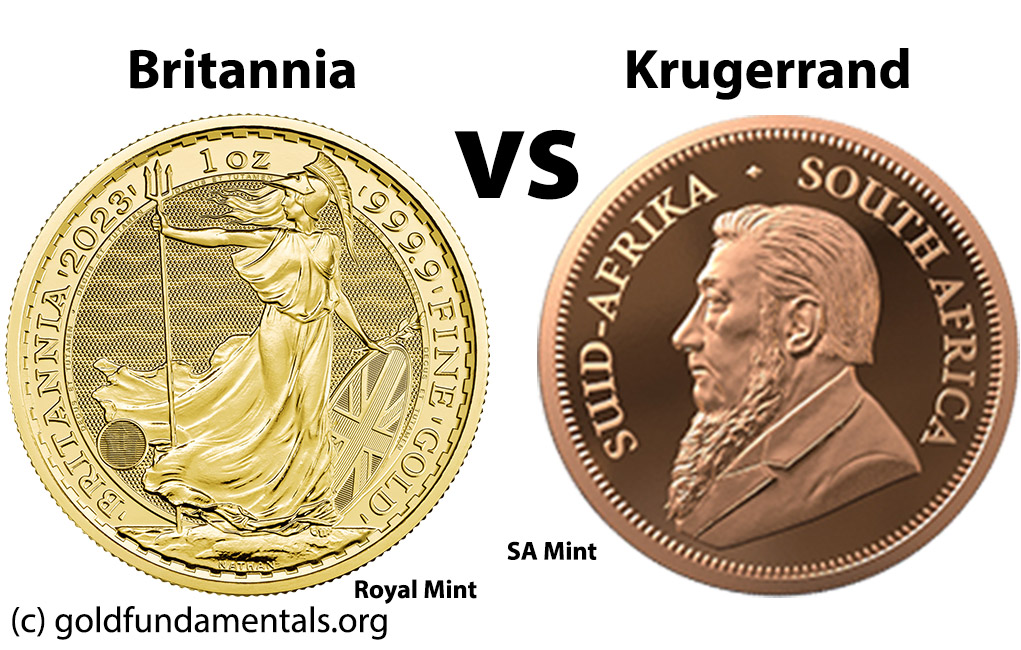The Britannia gold coin is a 24-karat bullion coin minted in Great Britain by the Royal Mint since 1987. It’s been produced mainly in four dominations: 1 oz, ½ oz, ¼ oz and 1/10. Accepted as legal tender in Great Britain, with face value from 100 GBP down to 10 GBP respectively. The Britannia stands out with four security features since 2021 and changing depictions of Britannia, the female personification of the United Kingdom.
KEY TAKEAWAYS
- The Britannia coin is in production since 1987 in four sizes, making it the oldest European bullion coin.
- It is a unusual investment coin, as the bullion gold coin is not produced every year and the depiction of Britannia changes nearly annualy.
- The coins security features – laser engravings and micro etchings – are top of their class.
This comprehensive overview gives an introduction to the Britannia coin, its history, design, specifications, advices for buying and selling, comparison to the oldest bullion gold coin: the Krugerrand from South Africa, and lastly the article answers frequently asked questions.
Contents
Part 1: What is the Britannia Gold Coin?

The Britannia Gold Coin is a British bullion coin that has been issued by the Royal Mint since 1987. Making it the first European Bullion coin, joining the ranks of other bullion coins minted around the world: the South African Krugerrand (1967), the Canadian Maple Leaf (1979) and the American Gold Eagle (1986). It is named after Britannia, the personification of Britain, who is depicted on the coin’s reverse. The obverse of the coin features the effigy of the reigning monarch.
The Britannia Gold Coin is minted in .9999 fine gold, making it one of the purest gold coins in the world. It is available in several denominations, including 1/2, 1/4, and 1/10 troy ounces. The 1-ounce coin has a face value of 100 pounds but its market value is typically much higher, based on the current price of gold.
The Britannia Gold Coin is considered legal tender in the UK, and its value is guaranteed by the British government. It is also exempt from Capital Gains Tax for UK residents, making it a popular choice for investment.
In addition to its value as an investment, the Britannia Gold Coin is also appreciated for its beauty and craftsmanship, and it holds a significant place in British numismatic history.
Seven Facts about the Britannica Coin:
| Topic | Fact |
| Mint | The Britannia coin is minted by the Royal Mint, one of the world’s oldest and most prestigious mints (founded in 886 AD). |
| Material | The Britannia coin is available in gold, silver, and platinum versions. |
| Purity | The gold and silver Britannia coins are minted in .9999 fine gold and .999 fine silver, respectively. |
| Design | The coin features the effigy of the reigning monarch on the obverse and the iconic figure of Britannia on the reverse. |
| Security | The Britannia coin incorporates advanced security features to protect against counterfeiting. |
| Legal Tender | The Britannia coin is legal tender in the UK, with its value guaranteed by the British government. |
| History | The Gold Britannia coin was first introduced in 1987, with the Silver Britannia following in 1997. |
Part 2: History of the Britannia Gold Coin
The Britannia Gold Coin has a rich and captivating history that stretches back to the times of the Roman Empire. The figure of Britannia, a personification of the British Isles, first graced the face of coins during the reign of the Roman Emperor Hadrian (117 – 138 AD). This iconic figure, often depicted with a trident and shield, has been a symbol of Britain’s strength and integrity for centuries.

Britannia has been depicted on coins struck by the Royal Mint for the last 350 years, since the reign of Charles II and every monarch thereafter.
The modern Britannia Gold Coin, as we know it today, was first issued by the Royal Mint in 1987. This was a significant milestone in Britain’s numismatic history. The coin was introduced as part of Britain’s effort to compete in the international bullion market, marking a new chapter in the nation’s rich tradition of coinage.
Initially, the Britannia Gold Coin was minted in 22-karat gold, also known as crown gold. This was a nod to the historic use of crown gold in British coinage. However, in 2013, the Royal Mint made a significant change. They increased the purity of the Britannia Gold Coin to 24-karat or .9999 fine gold, making it one of the purest gold coins in the world. This change reflected the evolving standards in the global bullion market and reaffirmed the Royal Mint’s commitment to excellence and innovation.
Table of Main Events of the Britannia Coin:
| Year | Event |
| 1987 | The Royal Mint introduces the Gold Britannia coin in four sizes with 22 carats. |
| 1997 | The Silver Britannia coin is introduced, expanding the Britannia series to include silver coins. |
| 1999 | The Gold Britannia coin’s gold content is changed from 22 karats to 24 karats. |
| 2013 | The Silver Britannia coin’s silver content is changed from .958 fine silver to .999 fine silver. |
| 2018 | Besides gold and silver, platinum joins the Britannia family |
| 2021 | The Britannia Gold Coin introduces new security features, making it one of the most secure coins in the world. |
| 2023 | The face of the monarch changes from Elizabeth II to Charles III. |
Part 3: Design and Features of the Britannia Gold Coin

An Look at the Coin’s Design
The obverse of the Britannia Gold Coin features the effigy of the reigning monarch. Since the coin’s inception in 1987, it has borne the likeness of Queen Elizabeth II. Over the years, the effigy has evolved, with three different artists lending their unique touch to the Queen’s portrait showing the aging queen. The latest design, by Jody Clark, has been in use from 2015 to 2023. In 2023 coins were still minted with the Queen’s face. The majority with the portrait of King Charles III.
The reverse of the coin is where the figure of Britannia herself is depicted. Britannia, with her trident and shield, is a symbol of Britain’s strength and resilience. The depiction of Britannica has been changed nearly yearly, designed several times by Philip Nathan (other designers are: Christopher Le Brun, John Bergdahl, Suzie Zamit, David Mach, Robert Hunt, Jody Clarck, Anthony Dufort, Lous Tamlyn, David Lawrence, James Tottle, P. J. Lynch, Sandra Deiana and Jonathan Olliffe for the 2023 design).
Security Features of the Britannia Coin
The coin has the most advanced security features of any coin worldwide making forgeries more cumbersome and easier to spot (read more on the website of the Royal Mint). The Canadian Gold Maple Leaf is another coin with security features, which are less sophisticated. The latest security features include:
- Latent image: this acts like a hologram changing its appearance from a padlock to a trident, depending on the viewing angle
- Surface animation: illusion of rowing waves behind the Britannia. These are created using advanced picolasers and come to life when the coin is rotated.
- Micro-text: the description “DECUS ET TUTAMEN” sourouding the figure of Britannia is created with lasers.
- Tincture lines: these lines depict colors and patterns on metal.
Watch a video about the security features of the Britannica Gold Coin:
Specifications
Besides the gold coin minted since 1987, the Royal Mint introduced in 1997 the silver bullion and in 2018 the platinum coin. Coins of all three metals depict the same image of the monarch and the Britannia.
The bullions are intended for collectors with a price only slightly higher than the gold spot price. The coin also comes in the higher quality proof finishing for collectors. Also unique compared to other common gold coins, the bullion (investor) finishing is not produced in every year. In some, only proof coins were minted.
All four sizes were first minted in 1987:
| Size | Diameter | Thickness | Weight | Face Value |
| 1 oz | 32.69 mm | 2.79 mm | 34,05 g | 100 £ |
| ½ oz | 27.00 mm | 2.08 mm | 17,025 g | 50 £ |
| ¼ oz | 22.00 mm | 1.63 mm | 8.513 g | 25 £ |
| 1⁄10 oz | 16.50 mm | 1.17 mm | 3.412 g | 10 £ |
Part 4: The Britannia Gold Coin vs the Krugerrand

The Britannia Gold Coin and the Krugerrand are both popular gold bullion coins that are sought after by investors and collectors worldwide. Here’s a comparison of the two:
Origin and Minting: The Britannia Gold Coin is minted by the Royal Mint in the United Kingdom, while the Krugerrand is minted by the South African Mint.
First Issued: The Britannia was first issued in 1987, while the Krugerrand was first issued earlier, in 1967.
Purity: The Britannia is minted in .9999 fine gold (24 carats), making it one of the purest gold coins in the world. On the other hand, the Krugerrand is minted in .9167 fine gold (22 carats), with the remaining alloy being copper, which gives the Krugerrand a more orange appearance compared to other gold coins. However, the gold content of each coins is the same, which gives the Krugerrand a higher weight (one ounce of gold plus copper).
Design: The obverse of the Britannia features the effigy of the reigning monarch of the UK, while the reverse showcases the figure of Britannia. The image of the monarch has changed over the years, relecting Queen Elizabeth’s II age and the change in 2023 to King Charles. The reverse side has a nearly annually changing Britannia. The Krugerrand features a portrait of Paul Kruger, the former President of the old South African Republic, on the obverse, and a springbok antelope on the reverse. Its design has been constant since 1967.
Legal Tender: Both coins are considered legal tender in their respective countries, with their value guaranteed by their governments. However, the gold content vastly exceeds the legal tender.
Investment: Both coins are popular choices for investment due to their gold content and wide recognition globally. However, the choice between the two often depends on the investor’s personal preference, tax considerations, and the premium over the spot price of gold at the time of purchase.
Remember, it’s always a good idea to seek advice from a financial advisor or a reputable coin dealer before making an investment in gold coins.
Part 5: Where to Buy and Sell the Britannia Coin?
When it comes to buying and selling Britannia Gold Coins, there are various avenues available for both collectors and investors. Here are some common channels:
- Bullion Dealers: Bullion dealers, both online and offline, are a primary source for buying and selling Britannia Gold Coins. These dealers specialize in precious metals and offer a wide range of options for purchasing gold coins. Reputable online dealers have established themselves as trusted sources for acquiring Britannia Gold Coins. It’s important to research and choose a reputable dealer to ensure authenticity and fair pricing.
- Coin Shops: Local coin shops are another option for buying and selling Britannia Gold Coins. These brick-and-mortar establishments specialize in numismatic items and often carry a variety of gold coins, including the Britannia. Coin shops provide the advantage of personal interaction, allowing you to examine the coin’s condition and authenticity before making a purchase. They may also offer competitive prices for selling your Britannia Gold Coins.
- Auctions: Online auction platforms, such as eBay, provide a platform for individuals to buy and sell Britannia Gold Coins. Auctions can offer opportunities for acquiring coins at competitive prices, but it’s essential to exercise caution and verify the seller’s reputation and the authenticity of the coin. Participating in auctions requires thorough research and careful bidding to ensure a fair transaction.
- The Royal Mint: The official website of the Royal Mint offers a direct channel for purchasing Britannia Gold Coins. As the minting authority, they provide new coins in various sizes and editions. Additionally, they may have pre-owned or limited edition Britannia Gold Coins available for sale. Buying directly from the Royal Mint can provide assurance of authenticity and quality.
- Banks and Financial Institutions: While less common than in the past, some banks and financial institutions offer gold coins for sale. If you prefer a more traditional approach or have an established relationship with a specific bank, it’s worth inquiring about their gold coin offerings.
- Coin Shows and Fairs: Coin shows and fairs attract coin enthusiasts, collectors, and dealers from around the world. These events provide an excellent opportunity to buy, sell, and trade Britannia Gold Coins. They offer a wide selection of coins and the chance to engage with knowledgeable experts in the numismatic community. Attending coin shows can be a valuable experience for expanding your collection or finding potential buyers for your Britannia Gold Coins.
When selling your Britannia Gold Coins, it’s advisable to obtain quotes from multiple buyers to ensure you receive a fair price. Consider factors such as the current market value of gold, the coin’s condition, and any unique attributes that may affect its desirability. Reputable bullion dealers, coin shops, and online platforms can provide estimates or make offers based on these considerations.
Remember to exercise caution and conduct thorough research before engaging in any buying or selling transactions. Consult with numismatic experts or financial advisors to gain insights into market trends, pricing, and the overall value of your Britannia coins.
FAQs
How much is a gold Britannia coin worth?
The value of a gold Britannia coin can vary based on several factors including the year of minting, the condition of the coin, and the current market price of gold. Most Britannia coins are a little over the spot price of gold (for bullion coins) to several thousand dollars (for rare or proof versions). It's recommended to check with a reputable coin dealer or financial advisor for the most current value.
What is the Britannia coin?
The Britannia coin is a series of British bullion coins issued by the Royal Mint in gold, silver, and platinum. The gold Britannia coin, first issued in 1987, is one of the most popular and is available in several denominations. The coin features the portrait of the reigning monarch on the obverse and the figure of Britannia on the reverse.
Is Britannia a bullion coin?
Yes, Britannia coins are bullion coins. They are minted in gold, silver, and platinum and are intended for investors rather than coin collectors. Bullion coins like the Britannia are valued primarily for their precious metal content rather than their rarity or numismatic value. However, not in all years the Britannia was minted as a bullion. In some years only with a proof finishing that is priced well above the spot price for gold.

